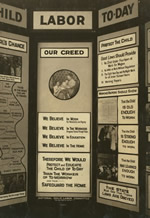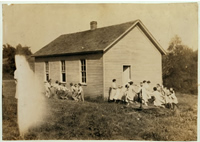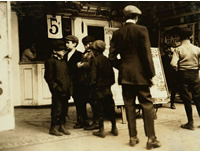Background and Scope |
Introduction | The Photos | The Photo Captions | Collection Strengths
Introduction
 Daisy Langford, 8 yrs. old works in Ross' canneries. LC-DIG-nclc-00796 |
Founded in 1904, the National Child Labor Committee set out on a mission of "promoting the rights, awareness, dignity, well-being and education of children and youth as they relate to work and working." Starting in 1908, the Committee hired Lewis W. Hine (1874-1940), first on a temporary and then on a permanent basis, to carry out investigative and photographic work for the organization. The more than 5,100 photographic prints and 355 glass negatives in the Prints and Photographs Division's holdings, together with the often extensive captions that describe the photo subjects, reflect the results of this early documentary effort, offering a detailed depiction of working and living conditions of many children--and adults--in the United States between 1908 and 1924.
Hine later referred to his photographic work for the NCLC as "detective work." Photo historian Daile Kaplan offers this picture of how Hine conducted his work, which was frequently regarded with suspicion by business owners, supervisors, and workers:
Nattily dressed in a suit, tie, and hat, Hine the gentleman actor and mimic assumed a variety of personas--including Bible salesman, postcard salesman, and industrial photographer making a record of factory machinery--to gain entrance to the workplace. When unable to deflect his confrontations with management, he simply waited outside the canneries, mines, factories, farms, and sweatshops with his fifty pounds of photographic equipment and photographed children as they entered and exited the workplace. (Photo Story: Selected Letters and Photographs of Lewis W. Hine. Ed. by Daile Kaplan. Washington: Smithsonian Institution Press, 1992).
 Exhibit panel. LC-DIG-nclc-04917 |
The NCLC distributed the photographs as part of its publicity and educational efforts.
- Hine and some of the other NCLC investigators included references to the photographs in reports on particular industries and locations.
- The NCLC used the photos to illustrate its own publications and succeeded in placing them in newspapers and progressive publications.
- The photos appeared in stereoptican slide shows and in displays that the NCLC circulated. Hine was influential in this effort, particularly after he was promoted to the head of the NCLC exhibits department in 1913.
Mrs. Gertrude Folks Zimand, acting for the NCLC in her capacity as chief executive, gave the records of the NCLC to the Library of Congress Manuscript Division in 1954, in celebration of the NCLC's fiftieth anniversary. The Manuscript Division then transferred to the Prints and Photographs Division the photographs (arranged in 21 albums), negatives, and caption cards. (The NCLC apparently also offered the Library of Congress a file of nitrate negatives, which the Library did not accept. Some original negatives can be found at the University of Maryland, Baltimore County and the International Museum of Photography and Film at George Eastman House. For further information, see "Related Resources.")
The Photographs
Many of the photo captions explicitly identify Hine as the photographer who made the image. A few captions cite other photographers or photo studios. Many captions lack any photographer attribution.
 Rock Spring School ... LC-DIG-nclc-00526 (an example of a flawed print in the collection) |
The photographic prints found in the NCLC records are on single weight paper. Most range in size from 3.5 x 3.5 inches to 5 x 7 inches and are probably contact prints from 4 x 6 inch and 5 x 7 inch negatives; both of those sizes are represented in the glass negatives in the collection. Hine apparently did not enjoy darkroom work and employed assistants to print his photographs whenever possible. Some of the prints show the effects of inadequate photographic processing and, quite possibly, wear and tear from their original use and housing.
Hine, or someone at the NCLC, numbered the photographs 1 - 5126, with some letter suffixes (e.g., 1A) to make the numbers unique. By convention, the Prints and Photographs Division has come to refer to these as "Hine numbers."
The NCLC delivered the collection to the Library of Congress in albums organized by type of industry and, within that, by Hine number. In 1968, Library staff remounted the photographs in new albums and subsequently microfilmed the collection, to reduce its handling. The Library contracted with JJT, Inc., to digitize the entire collection in 2003.
The Photo Captions
 Caption card for no. 3306 [retrieve corresponding catalog record] |
The online catalog records include title, location, and date information transcribed from the original 3 x 5 inch captions cards that came with the collection (for more information regarding transcription practices, see Cataloging the Collection).
The caption cards include a mixture of typed and handwritten information that is sometimes difficult to decipher. It appears that the NCLC had a system for reproducing the captions on strips of paper, because many of the caption cards consist of a label strip affixed to the card with added annotations above and below. Some strips were cut in such a way as to cut off information or attributions. Over the years, Library of Congress staff have added annotations to indicate the availability of corresponding negatives (an LC-H5 or LC-H51 stamp on a card signalled the availability of a corresponding glass negative that came with the collection) and, occasionally, to correct or amplify identification information given on the cards.
We do not know precisely who compiled the caption cards or how, although it seems logical to assume that Hine recorded the information they contain. Information on many cards echoes statements Hine made in his reports. Daile Kaplan, in editing Hine's letters, attributes the captions to Hine and notes that he later referred to the process of "synchronizing" the information with the photographs (Kaplan, p. xx). Having trained in stenography, Hine was no doubt in a good position to make rapid and detailed notes about the scenes and people he photographed.
In a few cases, it is apparent that the caption writer was working considerably after the taking of the photograph, because the caption refers to later revisiting of the same subject or indicates that information should be filled in at a later point if the correct identification can be found. Many captions cite the name of a witness (including other NCLC staff members or, sometimes, Hine's wife, Sara), as well as the name of the photographer. Some captions make reference to associated reports, many of which can be found in the Library of Congress Manuscript Division (see "Reporting on Labor Conditions").
Although the accuracy of the information in the captions cannot easily be verified, the captions often supply highly detailed and evocative information about the conditions being photographed and the photography enterprise itself.
- Many captions cite names, ages, addresses, work tasks, hours, and wages of individuals photographed. [examples]
- Many include quotes from the individuals depicted (sometimes in the caption writers' version of the speaker's colloquial English). [examples]
- Some captions include comments about the photography process, the photographer's interactions with those being photographed, or the reactions of those supervising the individuals the photographer planned to photograph. While some captions indicate that the photos captured more of a scene than even the photographer was conscious of, others indicate the inadequacy of photographs fully to convey a situation. [examples]
- The caption writer's moral judgments and sense of irony frequently come through in the captions. [examples]
Collection Strengths
The NCLC photographs, together with the captions, provide insight on the lives of working class families, with a particular focus on children and women. (For a contents summary, see Arrangement and Access.)
 122 Sullivan St. 2nd Floor rear. Leveroni family... New York, N.Y. LC-DIG-nclc-04071 |
Although the ethnicity of the photo subjects is not consistently identified in the captions, Hine photographed members of several immigrant groups, as well as African Americans in the work, home and school settings he covered.
Because of the detail the captions provide regarding locations and names of individuals and businesses, the collection can be a rich source for those conducting local and, possibly, family history (keeping in mind that the captions, which are not always easy to decipher, may contain inaccuracies and misspellings).
Some photos and captions comment by offering a before-and-after view of a particular set of workers [examples], while in at at least one case Hine visually compares the circumstances of product consumers with the makers of the product [examples].
Collectively, the material provides documentation useful for the study of many early twentieth century circumstances and developments:
- labor - in addition
to the concerted attention photos and
captions give to wages and working conditions,
clusters of images focus on:
- industrial and agricultural innovations, including both positive and negative sides of growing mechanization in industry and agriculture, and the swift and life-altering damage machines could do to humans [examples]
- movement of families from farms to factories and, sometimes, back again, particularly in the South [examples]
- the seasonal movements of migrant laborers [examples]
- what might, today, be termed "ergonomics"--the physical needs of the workers and how the work situation might accommodate them [examples]
 Going to the "Movies." This theatre makes no attempt to obey the state law... [LC-DIG-nclc-03814 ] |
- reform movements - in addition to the NCLC's overall effort to address the abuses of child labor, images and captions make reference to the work of settlement houses and allude to needed reforms and, in some cases, progress in:
- urban life with some attention to how red light districts and certain forms of entertainment may influence the morals of young workers in America's cities [examples]
- education - the NCLC records include the records of the National Aid to Education Committee, which John Dewey and others organized to promote federal aid to education; this may account for Hine's focus during that period on school attendance and conditions, particularly in Kentucky and Colorado, as well as schools for the blind and the deaf [examples]
- educational and social organizations, such as 4-H clubs [examples]
- institutions, such as orphanages, houses of "refuge" [examples]
- industrial and agricultural sites [examples]
Text prepared by: Barbara Orbach Natanson, Reference Specialist, Prints & Photographs Division
[START OVER] [ NEW SEARCH] [ "ABOUT" MENU] [ HELP]
 Library
of Congress
Library
of Congress( October 28, 2004 )